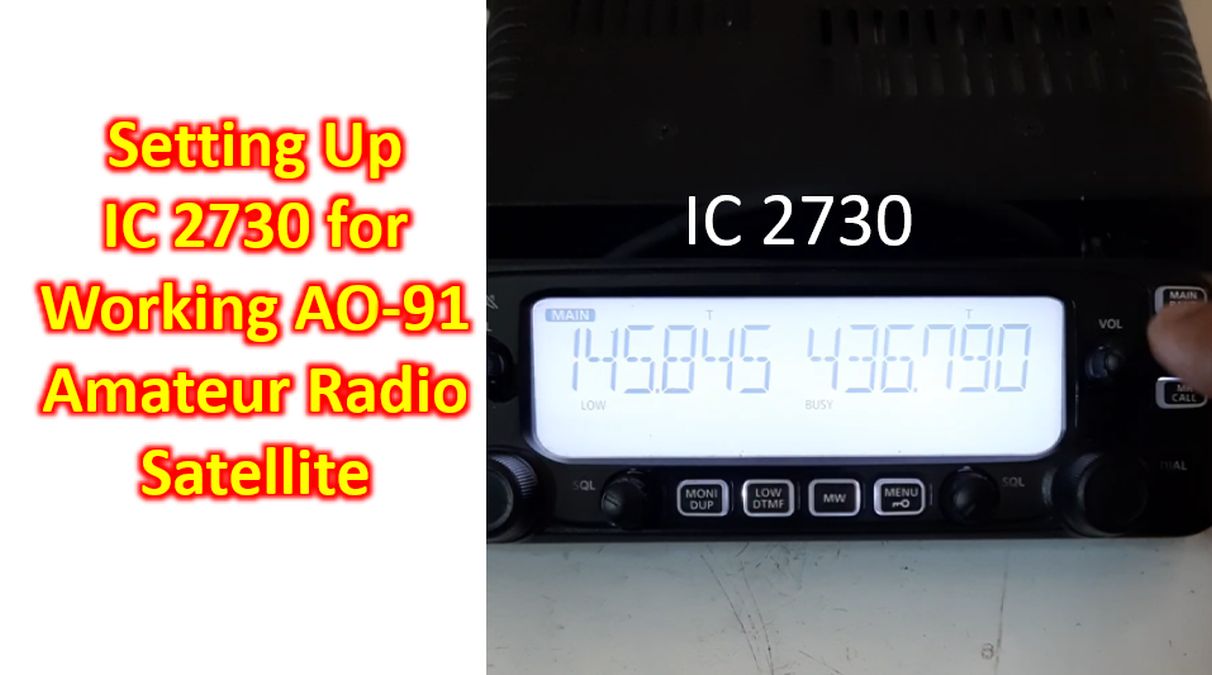Setting Up IC 2730 for Working AO-91 Amateur Radio Satellite
Setting Up IC 2730 for Working AO-91 Amateur Radio Satellite
IC 2730 is a full duplex VHF/UHF dual band FM radio which can be used for working LEO amateur radio FM satellites. AO-91 is a U/V amateur radio satellite, meaning that it has an uplink on UHF and downlink on VHF. As its battery is weak, the transponder can be used only when illuminated so that it will work on solar panels.

I usually find out the pass timing as well as Doppler shift in frequency from the Argentinian Amsat webpage. Though IC 2730 is a full duplex dual band radio, it has only one SO 239 antenna connector. Hence we so should use either a single dual band antenna or two antennas connected to one feedline with a diplexer. There is no provision to connect VHF and UHF antennas separately.
IC 2730 has two VFOs which can be tuned to any of the amateur radio VHF or UHF bands. I usually keep left sided VFO on VHF and right sided VFO on UHF. As most of the time I use VHF for transmission, the main band is kept on the left VFO. As AO-91 is a U/V satellite with uplink on UHF and downlink on VHF, I have to change the main band to the right side by pressing on the MAIN BAND button on the right upper corner of the radio. A highlighted display MAIN appears above the frequency display then.
Next I have to press on the V/MHz button just below that to change the tuning step from kHz to MHz to rapidly step down from 437 to 436 MHz. After that V/MHz button is pressed once again to change the tuning step to kHz.
Turning the large tuning knob on the right lower corner can bring the frequency displayed to the desired one on the Doppler tracking website. Here it is set at 435.240 MHz displayed before the satellite reaches the horizon. That point is known as acquisition of signal or AOS. From that point frequency starts changing on the website and we have to tune manually.
Left sided VFO is then tuned to the frequency shown on the website before AOS. As there was no need to change the MHz step, I did not use the V/MHz button. I just had to turn the tuning knob on the left lower corner. Frequency has been set at 145.965 MHz as shown on the website.
To set the CTCSS tone needed on the uplink, MENU button is pressed to access the R-TONE on the main band. MW button is the return button used for selection. Here the CTCSS tone was already set to 67.0 Hz. I am changing it up and down just to show how it is changed. Once the CTCSS tone is activated, ‘T’ appears above the frequency display, to the right of the highlighted MAIN display. Pressing V/MHz button takes us back to the frequency display.
Squelch is fully opened on the receive side, which is VHF for AO-91. Hissing sound comes through the loud speaker when the squelch is opened using the SQL knob. Satellite downlink signals are weak and usually not sufficient to open the squelch. That is why squelch is kept open. When satellite signal is being received well, the hissing sound comes down suddenly and you have to listen keenly to hear the conversation.
When the satellite reaches in range and starts rising above the horizon, the uplink frequency starts increasing. We have to change the frequency in the radio accordingly. If you have an antenna rotator, the moving compass needle on the Argentinian Amsat webpage will show the direction in which antenna has to be rotated, to track the satellite.
Doppler tuning is needed on the receive side as well. There the frequency decreases gradually as the satellite rises above the horizon. Changes on both sides are made as and when the displayed frequency goes off frequency by half the minimum frequency step in the radio. As IC 2730 has a minimum step of 5 kHz, retuning is done when it is off frequency by 2.5 kHz from the display on the website. When the satellite downlink is audible, slight up and down tuning may be required to get best reception.
One more step of UHF Doppler tuning is being shown here. It is a continous process on both uplink and downlink till the satellite disappears below the horizon. That point is known as loss of signal or LOS. Point of nearest location is known known as TCA or time of closest approach. Usually the frequency on uplink and downlink will be almost the nominal frequency at that point.